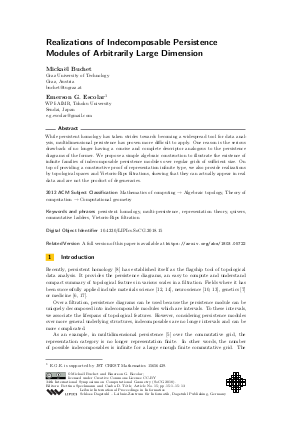Realizations of Indecomposable Persistence Modules of Arbitrarily Large Dimension
Authors Mickaël Buchet, Emerson G. Escolar
-
Part of:
Volume:
34th International Symposium on Computational Geometry (SoCG 2018)
Part of: Series: Leibniz International Proceedings in Informatics (LIPIcs)
Part of: Conference: Symposium on Computational Geometry (SoCG) - License:
 Creative Commons Attribution 3.0 Unported license
Creative Commons Attribution 3.0 Unported license
- Publication Date: 2018-06-08
File

PDF
LIPIcs.SoCG.2018.15.pdf
- Filesize: 490 kB
- 13 pages
Document Identifiers
Subject Classification
Keywords
- persistent homology
- multi-persistence
- representation theory
- quivers
- commutative ladders
- Vietoris-Rips filtration
Metrics
- Access Statistics
-
Total Accesses (updated on a weekly basis)
0Document
0Metadata
Abstract
While persistent homology has taken strides towards becoming a widespread tool for data analysis, multidimensional persistence has proven more difficult to apply. One reason is the serious drawback of no longer having a concise and complete descriptor analogous to the persistence diagrams of the former. We propose a simple algebraic construction to illustrate the existence of infinite families of indecomposable persistence modules over regular grids of sufficient size. On top of providing a constructive proof of representation infinite type, we also provide realizations by topological spaces and Vietoris-Rips filtrations, showing that they can actually appear in real data and are not the product of degeneracies.
Cite As Get BibTex
Mickaël Buchet and Emerson G. Escolar. Realizations of Indecomposable Persistence Modules of Arbitrarily Large Dimension. In 34th International Symposium on Computational Geometry (SoCG 2018). Leibniz International Proceedings in Informatics (LIPIcs), Volume 99, pp. 15:1-15:13, Schloss Dagstuhl – Leibniz-Zentrum für Informatik (2018)
https://doi.org/10.4230/LIPIcs.SoCG.2018.15
BibTex
@InProceedings{buchet_et_al:LIPIcs.SoCG.2018.15,
author = {Buchet, Micka\"{e}l and Escolar, Emerson G.},
title = {{Realizations of Indecomposable Persistence Modules of Arbitrarily Large Dimension}},
booktitle = {34th International Symposium on Computational Geometry (SoCG 2018)},
pages = {15:1--15:13},
series = {Leibniz International Proceedings in Informatics (LIPIcs)},
ISBN = {978-3-95977-066-8},
ISSN = {1868-8969},
year = {2018},
volume = {99},
editor = {Speckmann, Bettina and T\'{o}th, Csaba D.},
publisher = {Schloss Dagstuhl -- Leibniz-Zentrum f{\"u}r Informatik},
address = {Dagstuhl, Germany},
URL = {https://drops.dagstuhl.de/entities/document/10.4230/LIPIcs.SoCG.2018.15},
URN = {urn:nbn:de:0030-drops-87287},
doi = {10.4230/LIPIcs.SoCG.2018.15},
annote = {Keywords: persistent homology, multi-persistence, representation theory, quivers, commutative ladders, Vietoris-Rips filtration}
}
Author Details
References
-
Hideto Asashiba, Emerson G. Escolar, Yasuaki Hiraoka, and Hiroshi Takeuchi. Matrix method for persistence modules on commutative ladders of finite type. arXiv preprint arXiv:1706.10027, 2017.

-
Ibrahim Assem, Andrzej Skowronski, and Daniel Simson. Elements of the Representation Theory of Associative Algebras: Volume 1: Techniques of Representation Theory, volume 65. Cambridge University Press, 2006.

-
Michael Barot. Introduction to the representation theory of algebras. Springer, 2014.

-
Gunnar Carlsson and Vin de Silva. Zigzag persistence. Foundations of computational mathematics, 10(4):367-405, 2010.

-
Gunnar Carlsson and Afra Zomorodian. The theory of multidimensional persistence. Discrete &Computational Geometry, 42(1):71-93, 2009.

-
Lorin Crawford, Anthea Monod, Andrew X. Chen, Sayan Mukherjee, and Raúl Rabadán. Topological summaries of tumor images improve prediction of disease free survival in glioblastoma multiforme. arXiv preprint arXiv:1611.06818, 2016.

-
Mary-Lee Dequeant, Sebastian Ahnert, Herbert Edelsbrunner, Thomas M. A. Fink, Earl F. Glynn, Gaye Hattem, Andrzej Kudlicki, Yuriy Mileyko, Jason Morton, Arcady R. Mushegian, et al. Comparison of pattern detection methods in microarray time series of the segmentation clock. PLoS One, 3(8):e2856, 2008.

-
Herbert Edelsbrunner, David Letscher, and Afra Zomorodian. Topological persistence and simplification. Discrete Comput Geom, 28:511-533, 2002.

-
Emerson G. Escolar and Yasuaki Hiraoka. Persistence modules on commutative ladders of finite type. Discrete &Computational Geometry, 55(1):100-157, 2016.

-
Chad Giusti, Eva Pastalkova, Carina Curto, and Vladimir Itskov. Clique topology reveals intrinsic geometric structure in neural correlations. Proceedings of the National Academy of Sciences, 112(44):13455-13460, 2015.

-
Heather A Harrington, Nina Otter, Hal Schenck, and Ulrike Tillmann. Stratifying multiparameter persistent homology. arXiv preprint arXiv:1708.07390, 2017.

-
Yasuaki Hiraoka, Takenobu Nakamura, Akihiko Hirata, Emerson G. Escolar, Kaname Matsue, and Yasumasa Nishiura. Hierarchical structures of amorphous solids characterized by persistent homology. Proceedings of the National Academy of Sciences, 113(26):7035-7040, 2016.

-
Lida Kanari, Paweł Dłotko, Martina Scolamiero, Ran Levi, Julian Shillcock, Kathryn Hess, and Henry Markram. A topological representation of branching neuronal morphologies. Neuroinformatics, pages 1-11, 2017.

-
Yongjin Lee, Senja D. Barthel, Paweł Dłotko, S. Mohamad Moosavi, Kathryn Hess, and Berend Smit. Quantifying similarity of pore-geometry in nanoporous materials. Nature Communications, 8, 2017.

-
Michael Lesnick and Matthew Wright. Interactive visualization of 2-d persistence modules. arXiv preprint arXiv:1512.00180, 2015.

-
James R. Munkres. Elements of algebraic topology, volume 2. Addison-Wesley Menlo Park, 1984.

-
Monica Nicolau, Arnold J. Levine, and Gunnar Carlsson. Topology based data analysis identifies a subgroup of breast cancers with a unique mutational profile and excellent survival. Proceedings of the National Academy of Sciences, 108(17):7265-7270, 2011.

